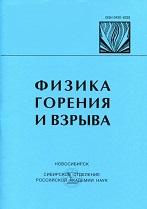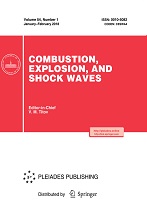|
This article is cited in 69 scientific papers (total in 69 papers)
Exploring formation pathways of aromatic compounds in laboratory-based model flames of aliphatic fuels
N. Hansena, J. A. Millerb, S. J. Klippensteinb, Ph. R. Westmorelandc, K. Kohse-Höinghausd
a Combustion Research Facility, Sandia National Laboratories, Livermore, CA, 94551, USA
b Chemical Sciences and Engineering Division, Argonne National Laboratory, Argonne, IL, 60439, USA
c Department of Chemical and Biomolecular Engineering, North Carolina State University, Raleigh, NC, 27695, USA
d Department of Chemistry, Bielefeld University, D-33615, Bielefeld, Germany
Abstract:
This presentation summarizes our recent experimental and flame modeling studies focusing on understanding of the formation of small aromatic species, which potentially grow to polycyclic aromatic hydrocarbons (PAHs) and soot. In particular, we study premixed flames, which are stabilized on a flat-flame burner under a reduced pressure of $\approx$15–30 torr, to unravel the important chemical pathways to aromatics formation in flames fueled by small C$_3$–C$_6$ hydrocarbons. Flames of allene, propyne, 1,3-butadiene, cyclopentene, and C$_6$H$_{12}$ isomers 1-hexene, cyclohexane, 3,3-dimethyl-1-butene, and methylcyclopentane are analyzed by flame-sampling molecular-beam time-of-flight mass spectrometry. Isomer-specific experimental data and detailed modeling results reveal the dominant fuel-destruction pathways and the influence of different fuel structures on the formation of aromatic compounds and their commonly considered precursors. As a specific aspect, the role of resonance-stabilized free radical reactions is addressed for this large number of similar flames of structurally different fuels. While propargyl and allyl radicals dominate aromatics formation in most flames, contributions from reactions involving other resonance-stabilized radicals like $i$-C$_4$H$_5$ and C$_5$H$_5$ are revealed in flames of 1,3-butadiene, 3,3-dimethyl-1-butene, and methylcyclopentane. Dehydrogenation processes of the fuel are found to be important benzene formation steps in the cyclohexane flame and are likely to also contribute in methylcyclopentane flames.
Keywords:
formation of polycyclic aromatic hydrocarbons and soot, resonance-stabilized free radicals, hydrocarbon flames, identification of species in flames, molecular-beam mass spectrometry, photoionization by vacuum ultraviolet.
Received: 01.10.2011
Citation:
N. Hansen, J. A. Miller, S. J. Klippenstein, Ph. R. Westmoreland, K. Kohse-Höinghaus, “Exploring formation pathways of aromatic compounds in laboratory-based model flames of aliphatic fuels”, Fizika Goreniya i Vzryva, 48:5 (2012), 17–26; Combustion, Explosion and Shock Waves, 48:5 (2012), 508–515
Linking options:
https://www.mathnet.ru/eng/fgv1033 https://www.mathnet.ru/eng/fgv/v48/i5/p17
|


| Statistics & downloads: |
| Abstract page: | 41 |
|





 Contact us:
Contact us: Terms of Use
Terms of Use
 Registration to the website
Registration to the website Logotypes
Logotypes








 Citation in format
Citation in format 
